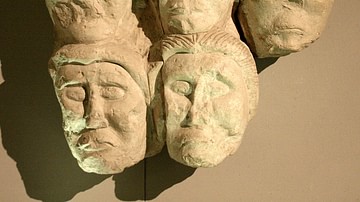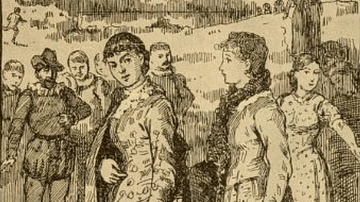Search Images
Browse Content (p. 635)

Image
Saint Peter Enthroned
Statue of Saint Peter sitting in a chair and holding the keys of heaven in Saint Aloysius' church, Glasgow.

Image
Saint Peter Heals the Cripple
Detail from a window depicting Saint Peter healing a cripple in Exeter College Chapel, Oxford.

Image
Celtic Heads Sculpture, Entremont
A stone sculpture of human heads, the part of the body believed by the ancient Celts to hold the soul. From a sanctuary at the oppidum of Entremont, France. 2nd century BCE. (Musée Granet, Aix-en-Provence, France)

Image
Figures & Head Columns from Celtic Roquepertuse
Seated figures and stone columns with niches for human heads or skulls from a Celtic religious site at Roquepertuse, France. 3rd century BCE. (Musée d'histoire, Marseille, France)

Image
Wampanoag Canoe
Traditional Wampanoag canoe at the Wampanoag homesite exhibit of the living history museum Plimoth Plantation, Plymouth, MA.

Image
Roman Sculptures from Perge
The Antalya Museum in southern in Turkey houses a unique collection of Roman marble sculptures from the ancient city of Perge in Pamphylia. Dated to the 2nd and 3rd centuries CE, they decorated the theatre, the city gate and other monuments...

Image
Weary Hercules Statue from Perge
Statue of Hercules discovered in 1980 at the ancient city of Perge in southern Turkey. It was reproduced in the late 2nd century CE from the 4th century BCE original by the Greek sculptor Lysippos. The top half of the statue was smuggled...

Image
Wampanoag Village
The Mashpee Wampanoag Indian Museum, Mashpee, MA.

Image
Statue of a Dancing Woman
Marble statue of a dancing woman, 2nd century CE. The statue was found in Perge and is now in the Antalya Museum in Turkey.

Image
Jamestown Colonists Choosing Brides
Colonists choosing wives, illustration from page 147 of Stories of the three Americas. Their discovery and settlement by Eunice C. Corbett and Anna Content, Chicago, A. Flanagan, 1890 CE.
Library of Congress